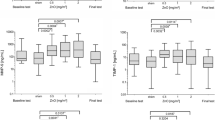Abstract
Objective. To test the hypothesis that exposure to thermal-degradation products of polyurethane (PUR), particularly isocyanates, induced nasal inflammation.
Methods. Thirty-eight workers –14 with a history of work-related nasal symptoms (WRS/Nose), and 15 referents without such history – exposed to sprayed and heated PUR glue, were studied with regard to biomarkers of isocyanate exposure [4,4′-diphenylmethane diisocyanate (4,4′-methylenediphenyl diisocyanate; MDI) and 2,4- and 2,6-toluene diisocyanate (TDI), determined as 4,4′-diphenylmethane (U-MDX) and 2,4- and 2,6-toluene (U-2,4 and U-2,6-TDX) diamine in hydrolysed urine and nasal lavage fluid (NAL)], inflammation [albumin; eosinophilic cationic protein (ECP); myeloperoxidase (MPO) and cells in NAL], serum IgG specific for MDI (S-IgG-MDI) and TDI (S-IgG-TDI), and nose symptoms. Nine unexposed office workers were also examined.
Results. The exposure to sprayed and heated PUR glue, especially when heated by gun, was associated with the presence of biomarkers of isocyanate exposure in urine; after work the levels [median (range)] in all workers were: U-MDX 0.32 (≤0.1–1.5); U-2,6-TDX 0.33 (≤0.1–0.71) µg/g creatinine. Also, 5/38 workers had detectable levels in NAL. Furthermore, the biomarkers of inflammation in NAL – albumin (P≤0.05; Kendall), MPO (P=0.01), and neutrophils (P≤0.01) – showed similar patterns of relationships with the exposure to glue heated by guns. After work, workers who had complained of WRS/Nose had higher levels of albumin (medians 3.5 vs. 1.9 mg/l; P=0.05, Mann-Whitney U-test) and MPO (14 vs. 11 µg/l; P≤0.05) in NAL than those who had had no such complaints. U-2,6-TDX, as well as S-IgG-MDI and S-IgG-TDI, were associated with increased levels of the inflammation biomarkers, U-2,6-TDX also with the symptoms. As expected, acute symptoms after exposure were associated with the inflammation biomarkers.
Conclusions. The present data indicate that thermal degradation products of PUR induced a 'chronic' rhinitis. At exposure, there was an accentuation of symptoms; the signs of acute inflammation were less obvious.
Similar content being viewed by others
Author information
Authors and Affiliations
Additional information
Electronic Publication
Rights and permissions
About this article
Cite this article
Littorin, M., Welinder, H., Skarping, G. et al. Exposure and nasal inflammation in workers heating polyurethane. Int Arch Occup Environ Health 75, 468–474 (2002). https://doi.org/10.1007/s00420-002-0337-1
Received:
Accepted:
Issue Date:
DOI: https://doi.org/10.1007/s00420-002-0337-1




